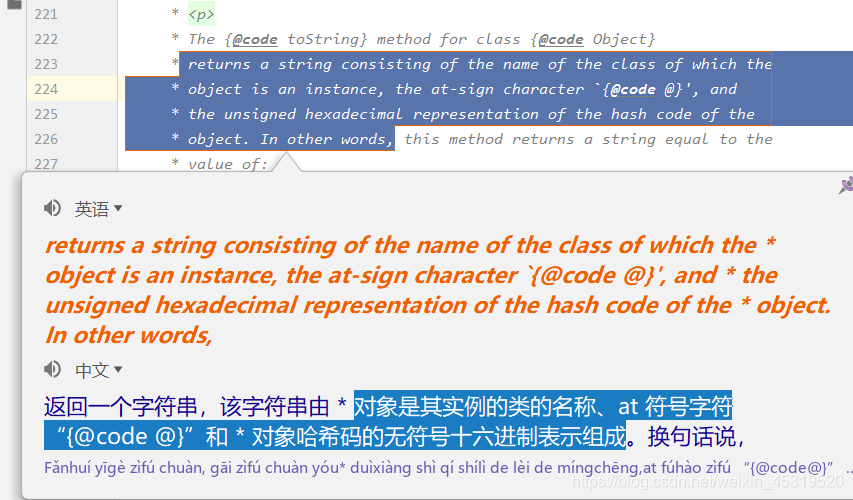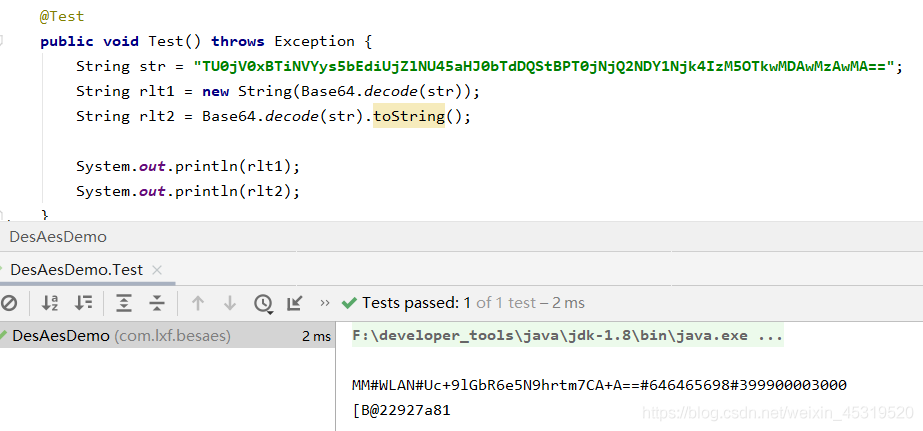@[TOC](toString() 和 new String()用法区别)
本文讨论的是在加密解密的过程中其2者使用的区别
先上源码
/** * <p> * The {@code toString} method for class {@code Object} * returns a string consisting of the name of the class of which the * object is an instance, the at-sign character `{@code @}', and * the unsigned hexadecimal representation of the hash code of the * object. In other words, this method returns a string equal to the * value of: * <blockquote> * <pre> * getClass().getName() + '@' + Integer.toHexString(hashCode()) * </pre></blockquote> * * @return a string representation of the object. */public StringtoString(){returngetClass().getName()+"@"+ Integer.toHexString(hashCode());}
getClass().getName() + ‘@’ + Integer.toHexString(hashCode())
通俗的说:toString()返回的是其实例类名+@+对象的哈希码
继续上源码
如何插入一段漂亮的代码片
去博客设置页面,选择一款你喜欢的代码片高亮样式,下面展示同样高亮的代码片.
/** * Constructs a new {@code String} by decoding the specified array of bytes * using the platform's default charset. The length of the new {@code * String} is a function of the charset, and hence may not be equal to the * length of the byte array. * * <p> The behavior of this constructor when the given bytes are not valid * in the default charset is unspecified. The {@link * java.nio.charset.CharsetDecoder} class should be used when more control * over the decoding process is required. * * @param bytes * The bytes to be decoded into characters * * @since JDK1.1 */publicString(byte bytes[]){this(bytes,0, bytes.length);}
通俗的说:new String()返回的是一串通过平台默认字符集解码后得到的字符串且长度可能会与原字符串不等
举个例子:
@TestpublicvoidTest()throwsException{String str="TU0jV0xBTiNVYys5bEdiUjZlNU45aHJ0bTdDQStBPT0jNjQ2NDY1Njk4IzM5OTkwMDAwMzAwMA==";String rlt1=newString(Base64.decode(str));String rlt2=Base64.decode(str).toString();System.out.println(rlt1);System.out.println(rlt2);}
那什么时候用什么方法呢?
new String()一般使用字符转码的时候,byte[]数组的时候用
toString()对象打印的时候使用
热门文章
- 长春宠物同城领养(长春市领养宠物狗)
- 4月9日→18M/S|2025年最新免费节点Shadowrocket/Clash/V2ray/SSR订阅链接地址
- 3月21日→20.8M/S|2025年最新免费节点V2ray/Shadowrocket/Clash/SSR订阅链接地址
- 宠物粮食加工厂加盟条件是什么样的呢(小型宠物粮加工厂需要什么手续)
- 没经验的新手开宠物店怎么样?(零基础开宠物店)
- Cpp的异常处理Exception Handling-笔记
- 4月8日→22.6M/S|2025年最新免费节点Shadowrocket/V2ray/Clash/SSR订阅链接地址
- 自学Python3中的while循环语句,break和continue语句
- python多线程编程_2小时玩转python多线程编程
- 动物医院办理条件要求标准规范最新的简单介绍